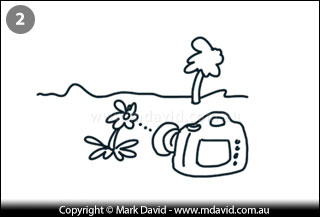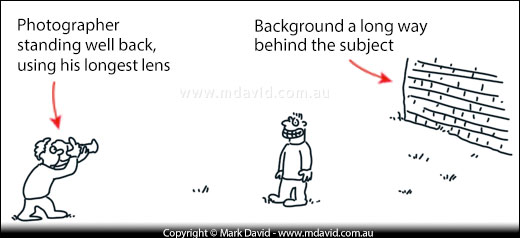
Sometimes you want to stop the background from mucking up your photo. It’s handy knowing how to isolate your subject from everything going on behind it. And digital SLRs make it easy.

A bunch of the tricks mentioned below made this paper wasp stand out in this shot.
You don’t have to do all the things I’m about to describe, certainly not all at once anyway. But a combination of some of these tricks is going to make your subject pop out of its background.
Base your choice of methods on whatever you think will look best.
Move your subject away from distractions
This is so obvious I almost decided not to mention it. And yet people often forget.
The main difference between the pros and the amateurs is that the pros think more about stuff like this before they start taking pictures.
And if your subject is a different distance from you compared with everything else in the frame, then that will help too, because your subject will then also stand out for being the only thing in focus.
Framing your shot
Here’s another one which is so obvious that many people forget to do it. When most people take a photo, they concentrate so much on their cameras and getting their subject in focus and so on, that they forget about what’s happening in the photo, including the background. Often all the photographer needs to do is move a little to or zoom in a bit and some distraction behind or near the subject will no longer be in the shot. Seriously, if something’s not adding value to your picture then ask yourself, why is it still in the frame?

A big aperture was all that was needed to make the textures on the background wall smear themselves into a plain colour.
Contrast
Look for contrasts. For example, if your subject is red, then a green background (like a lawn) will make it stand out. Other colour contrasts are yellows/oranges contrasting against blues/purples. Light-dark contrasts work nicely too.
Big aperture (a small f-number)
You’ve read the getting started article now — I mean, of course you have — so you now understand what aperture does. Okay, I’ll remind you: a big aperture (small f-number) will give you a small depth of field that can work miracles for blurring away backgrounds. So you flick your camera into aperture priority mode and pick a small f-number. Something like f/2.8 or even f/5.6 is likely to make a noticeable difference, but be aware that with a really small f-number you might not be able to get all of your subject in focus. If that happens when you’re photographing a person, then focus on their nearest eye.
Change your angle


1: Looking down on the flower means the ground is also likely to end up looking sharp. 2: Taking the shot from the flower’s level means the horizon becomes the background, which will be so far away that it’s bound to be nicely out of focus.

Here’s an example of using camera angle to isolate the subject. By taking this photo at the Magpie’s eye level, I was able to make this picture all about the bird.
A glance at the graphics above will reveal that looking down on something like a flower will not only give you the world’s most common (and potentially boring) view of a flower, but it will also get the ground in near-focus, where it’s going to compete for attention. So if change the angle you take the shot, in such a way that the background is not so close to your subject, then depth of field limitations will guarantee that your subject is the only thing looking sharp.
That’s one of the reasons I often get down low onto the ground when I’m taking photos of small things — photographing a subject at its own level means a distracting patch of ground is replaced by a nice, clean blurry horizon. The picture of the magpie above shows what I’m talking about.
And that’s going to make your subject pop out.
Telephoto
I dedicated a page (only a short one) to how this trick works. The graphic below shows what I’m about to describe.
The idea is that if you get your subject standing way out in front of its background, and then you stand a long way away too, photographing your subject with a telephoto lens. What that does is to give you nice blurry backgrounds that help your subject stand out.
It’s not because the telephoto puts the background out of focus any more, but because it only sees a tiny patch of that out-of-focus background and smears that right across the frame behind your subject. Like I said, I explain that concept a whole lot better in that article I just referred to.
The opposite thing happens with a wide-angle lens. A wide-angle allows you to see so much of the surroundings that you won’t even notice things falling out of focus. Plus, depth of field is bigger in wide-angle lenses. In extreme wide-angle lenses depth of field is so huge that pretty much everything is going to look sharp.

Moving in closer
Yes I know, I just told you to stand a long way away and now I’m telling you to get closer. Well, to clarify things, what I’m asking is to find a certain sweet spot — not too far and not too close either. The graphic above should give you a rough idea about what’s going on. You see, when the subject you’re focusing on is closer, depth of field gets smaller. Which is going to blur the background away better behind your subject. So you want to be as close as you can while also using your longest lens zoomed in as much as it can go. It will seem like one thing is cancelling out the other, but in fact what you’re doing is making your subject stand out better.
Sneaky use of your flash
In very weak light, using your flash to illuminate just your subject is obviously going to make the subject stand out. But you can be much sneakier than that. For example, late on a cloudy day, the colour of the ambient light can be a little blue. Using a flash on your subject will make your subject contrast by giving it warmer colours. The effect is subtle but it will be enough for people to notice your subject more.
And you can take this trick to extremes too, by putting warm coloured gels over your flash to make your subject look too yellow. Then in your RAW image editing software, you drag the colour temperature sliders to make your subject look the way it should. As your subject starts looking normal, your background (which wasn’t tinted yellow by your flash) is going to start looking really blue in an arty kind of way. That effect is going to look unnatural and might be a bit funky for some people’s taste, but then I mention it because it’s an example having fun with photography. Oh yeah, and because it will certainly make your subject stand out.








